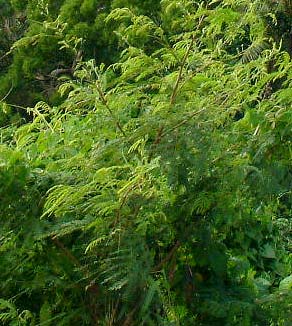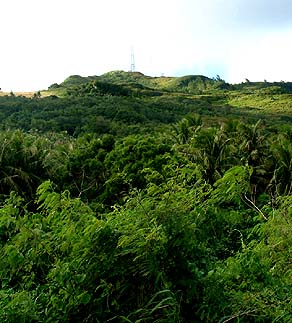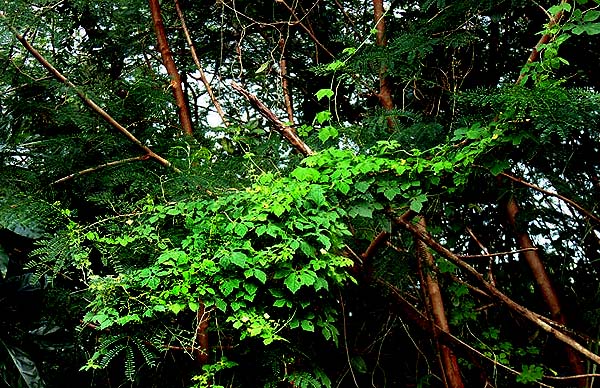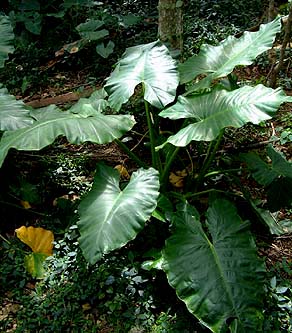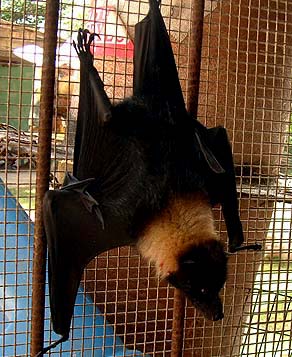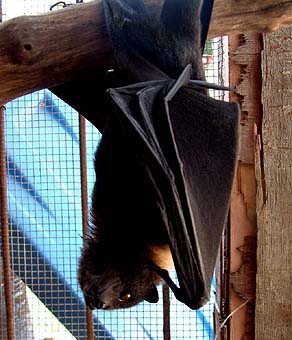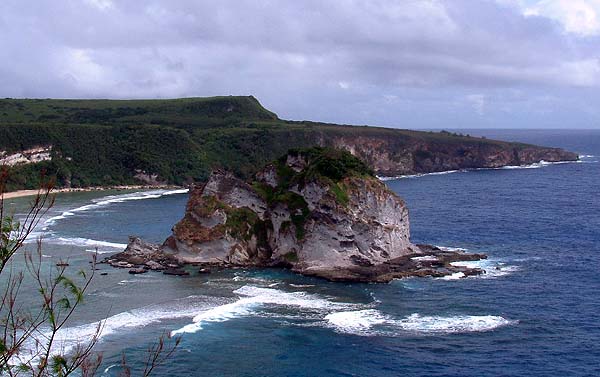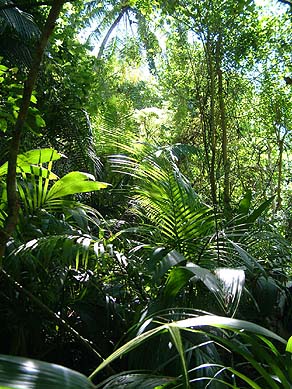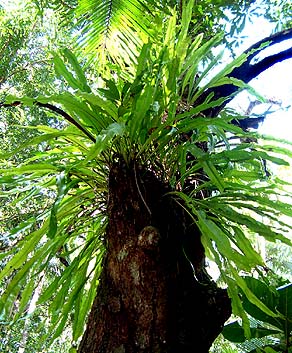 |
 |
 |
|||||
|
|
|
|
|
|
|
|
|
|
|
|||||||
|
|
|
|
|
|
“After the War, not a single living tree was standing here on Saipan,” Ben asserts. “The Japanese had dug into the land for their protection and for warfare planning, into caves and all of that, and of course, if you’re going to map out your target area, you’re going to denude the plants. Fortunately in those days, in the Second World War, they don’t have any bromide chemicals, like the Agent Orange used in Vietnam, which defoliates everything. In those days it was all burning, and they brought in tanks with cannons that shoot out fire, and they had all these backpack-type flamethrowers and they would burn everything in sight. So not a single tree was standing after the war."
|
||
|
|
||
“Immediately afterwards, the military planners began to think, ‘Oh, we have to get some plants going in Saipan.’ They didn’t know what diseases would come up with all these dead people and dead animals, so they re-seeded this place with a plant called tangan tangan. The seeds were brought in from Hawai‘i, and were put on the plane, and just dumped in the air, and they’re all over Tinian and Saipan. "Tangan tangan are legume plants. We kind of like it. They’re fast growing, which is good. In the olden days, we didn’t have electric or gas stoves; we used wooden stoves. Tangan tangan became very useful for us. We would cut them down a week before we took them for firewood, and as we continued to cut, they would grow, and we would cut and they would grow."
|
|
|
“Because they’re legume plants, they probably have nitrogen-fixing bacteria in their root system, so it’s good for replenishing the soil, as they use the soil and replenish it with nitrogen resources. And of course, their leaves break down and become a good potable soil. Tangan tangan is also good for cattle feed, except they grow fast and they grow taller than the cattle. So as the cattle owner, you have to go and cut them down, and they will sprout, and you cut them down.” “Forest was very important in our life a long time ago,” Dave says. “We cut posts of the tangan tangan for fencing and we also used the posts for building houses. Tangan tangan was a very common material that we used a long time ago. Some people still don’t have enough lumber, so they have to go out and cut the tangan tangan posts or whatever kind of wood post that is fit for building a house. This is not a permanent structure—it would only decay in the future. But it is one source of material that we used to come up with for building a house.”
|
“Now native trees are not only coming back,” Ben remarks, “but they’re protected by law. And we have forest areas that have been designated. Unfortunately they have mixed the raising of cattle with forest land. If the owners of these animals can manage certain cattle ranching activities, I believe that the native forest and the farmers of cattle can coexist. "If they don’t do management plans, I see problems because of the stomping activities of cattle. They may denude the land, because they take away a lot of the grass areas, and eventually, during rainy season, you’ll have runoff from too much rain, and almost all runoffs end up in the ocean.”
|
|
|
|
|
|
The forest is also an important source for the gathering of food and medicinal plants. “We would gather yam of the forest,” recalls Rosa Castro, “and a similar yam, again of the forest, with a different name, called gaddo’. Gaddo’, nika, dagon, lemmai. We would gather betel nut in the forest and wild nika, which is about the same as the yam, wild gaddo’. This one has a lot of thorns. The marrow would produce thorny roots, wood-like, and the female gaddo’ is the one that you can use to cook. And we would also gather breadfruit, banana and also the elephant taro. Those are the ones that when we go in the forest we collect and bring back home.”
|
||
|
|
||
“You have to grow up with this kind of taro,” Ben points out, “because if we go in the woods, I would pick the taros that I know we can eat. You would pick any kind of taro but then you would get really itchy because the kind you picked isn't palatable or edible. But I asked Rosa about the famine time, what did they eat, and she said probably any kind of taro, even those that are not normally edible.” “There’s one tree back here I haven’t seen today,” Rosa adds. "They would pick the seeds and process them and eat them during the time of no food. “I myself do not eat fruit bats because I’m scared. During the Japanese time when they caught fruit bats, I saw some of my family members eat fruit bats. But I just don’t eat fruit bat. I don’t know how they used to catch it because I was scared.”
|
|
|
“Fruit bats are indigenous mammals to the islands,” Ben explains. “They are perhaps the first mammals to settle the Marianas. Guam, Rota, Tinian, Saipan and the rest of the northern islands have populations of Marianas Fruit Bats. “Fruit bats are the favorite food for the Chamorros. The Carolinians don’t particularly care to eat fruit bats, but it’s a delicacy for the Chamorros. I don’t know why, but people of Chamorro descent prefer fruit bats more than almost any other kind of meat. "And they don’t waste hardly anything in there. Only the hard bones, maybe the skulls and the teeth are discarded. From the furs to the stomach, everything is eaten. And you know the rubbery part of the bats, the modified hair used as wings, are the delicious part of the fruit bats."
|
“Now that’s why they were hunted down almost to extinction here on Saipan. The advent of guns kind of decimated the populations of fruit bats on Tinian, on Saipan. And there’s another island south of Tinian called Goat Island, Aguijan, that used to have lots of fruit bats, but the advent of shotguns changed that. Now big shotguns are illegal. Only the small, 410 shotgun is legal here. And the bats are now a protected species. We had them protected by our local laws, and then the Federal Government came in and listed the fruit bat as a threatened species. “But from Anatahan up to Agrigan, fruit bats thrive up there, simply because there’s not enough people hunting them, and also because there’s more Carolinians up there who are not very keen on eating fruit bats. So that saves a lot.”
|
|
|
|
|
|
“On Saipan, about seven or eight years ago, we found a colony here consisting of about 38 bats. And on occasion, when I go up early in the morning, on Bird Island Lookout, I am able to observe, at most, eight fruit bats making their rounds in those areas, coming back from eating, so I guess there’s natural forest in there. It’s a protected forest and I suppose fruit bats take refuge in those areas."
|
||
|
|
||
“My mother and my father told us that as long as we live, those ancient people, taotaomo’na, are still alive,” Estella says. “But we cannot see them because they cannot come out during daytime because of the light. Only at night time. So, in case we need to go to the bathroom, I always ask first, because my parents told us to ‘remember that’s not your place. People are still living in this place. So if you go there, you have to ask for permission or you’re going to get sick.’ So that is the reason why we always ask.” “People ask the ancestors of the first of the Chamorros who were here and are gone,” Ben explains, "even if they’re not there, because they believe in their spirit, taotaomo’na. Taotaomo’na does not necessarily mean ‘ghost.’ People get scared and they think it means 'ghost' but, no, it’s just the first people. I go down to the cemetery, and because my mom and my dad are the first people in my life, I speak to them in the cemetery as if they were alive. And that’s what we do in the jungle. "
|
|
|
“In the old times and up to now,” Dave states, “for those people who believe in the Taotaomo’na, before you go into the forest, you need to harvest the tip of a plant we call lada. Just the tip of the plant. You need to harvest it and smash it, rub it up in your hands and smash it, and then when it gets soft, you have to rub it all around your body. "And then that one will protect you in going hunting for coconut crab, or going hunting for anything like deer. When you rub it around your body, you’re asking permission to go hunting for whatever is needed for your consumption."
|
“My mom, wherever we went in the jungle, if we had cigarettes, she would light one and leave it down on the ground,” Rosa recalls. “If we’re in the stream showering, if we’re going to eat, we again get some food and put it on the ground. That’s our custom. That’s my mom’s custom that she learned from the elders. I remember also the custom of the Chamorro, and the taotaomo’na. And my mom, we also believed that. And we’re respecting that. If I am going to get betel nuts, I will ask first. Ask the taotaomo’na.” “We show respect to the first people and ask them permission," Ben concludes, "ask them permission to pee in the forest, to defecate in the forest, to get betel nut in the forest, to get breadfruit in the forest. The respect is there at all times, even today. When I go in the woods and I need to relieve myself, I would definitely ask (he gives a little chant in Chamorro)."
|
|
|
“My grandmother was the traditional doctor,” Pete says. “The reason why I’m not interested in that kind of traditional medicine is because you need to get up at like 3:00 in the morning to go look for medicine, sometimes in the jungle, and I got fed up with that. Roots, leaves, barks, anything. We knew the plants. "I don’t use them now. But before, when my grandmother was still alive, at 3:00 in the morning she’d say ‘I need this tree.’ And the only place to find it is inside the jungle. Three o’clock in the morning, we’d go inside the jungle, and that was a scary thing.”
|
|
|
|
Forests on Saipan reflect the availability of water on the island.
|
||
|
|
||
|
|
|
|
|
|

|
| Tanapag Home | Map Library | Site Map | Pacific Worlds Home |
|
|
|
|

|
|
|
|||
| Copyright 2003 Pacific Worlds & Associates • Usage Policy • Webmaster |
|||

